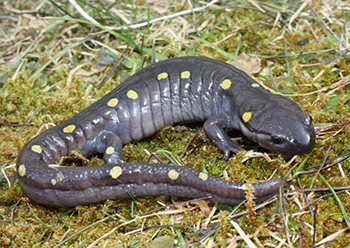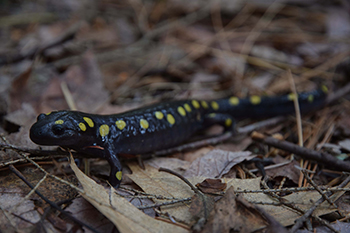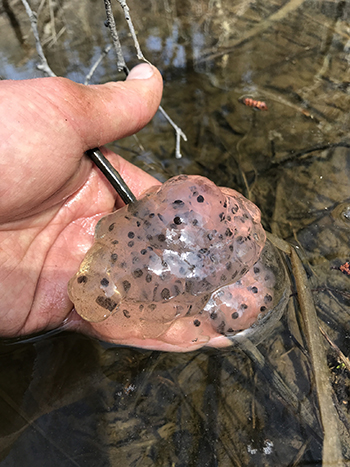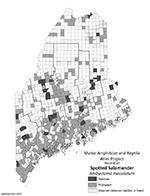Home → Fish & Wildlife → Wildlife → Species Information → Reptiles & Amphibians → Spotted Salamander
Spotted Salamander
Ambystoma maculatum
On this page:

Photo: Trevor Persons
Distinguishing Characteristics

Photo: Derek Yorks
- Large, approximately 6 to 8 inches in length
- Blue-black, black, or gray-brown, with bright yellow spots arranged in two irregular rows along the back and tail
- Broad head
- Light gray or light blue underside
Status and Distribution in Maine
- Common
- Statewide
Habitat
- Forests, especially mature deciduous forest
- Uses burrows beneath rocks, rotting stumps and logs, moss, and debris piles
- Primarily breeds in vernal pools, just after snowmelt in spring
Diet
- Eats wide variety invertebrates including insects, spiders, earthworms, and beetle larvae and adults
Seasonal Changes
- Hibernate in rodent burrows, under stumps, or in other underground recesses beneath forest floor
Natural History Notes

Photo: Derek Yorks
- Majority of members of spotted salamander populations will migrate, often across roads, to vernal pools on “Big Night,” the first night of warm rain following the spring thaw
- Male and female salamanders perform an energetic mating dance after reaching the pool
- Following mating dance, females lay 2–3 globular egg masses containing up to 200 eggs each
Share Your Sighting
There is much still to learn about the distribution and ecology of Maine’s herpetofauna, and we encourage members of the public to share their photo-documented observations as part of the Maine Amphibian & Reptile Atlas Project (MARAP).
To see if a township still needs documentation of a species, consult this distribution map (PDF). If a township lacks a photo or specimen record, we want your observation!
There are two ways to share your observations:
Submit your reptile or amphibian observation online
No service? No problem. Click here to download the survey to your device while connected, then take offline to collect observations from anywhere. Tip: The survey works best on Google Chrome and Safari.
Or upload sightings to the iNaturalist citizen science project through their website at iNaturalist.org or mobile app.
- When submitting an observation through iNaturalist add a description of the location (and other noteworthy information) to the “notes” field. This serves as a check on the locations automatically generated by smartphone cameras, which may be imprecise if cell service or GPS coverage is weak.
Thank you for doing your part to help conserve Maine’s reptiles and amphibians.
